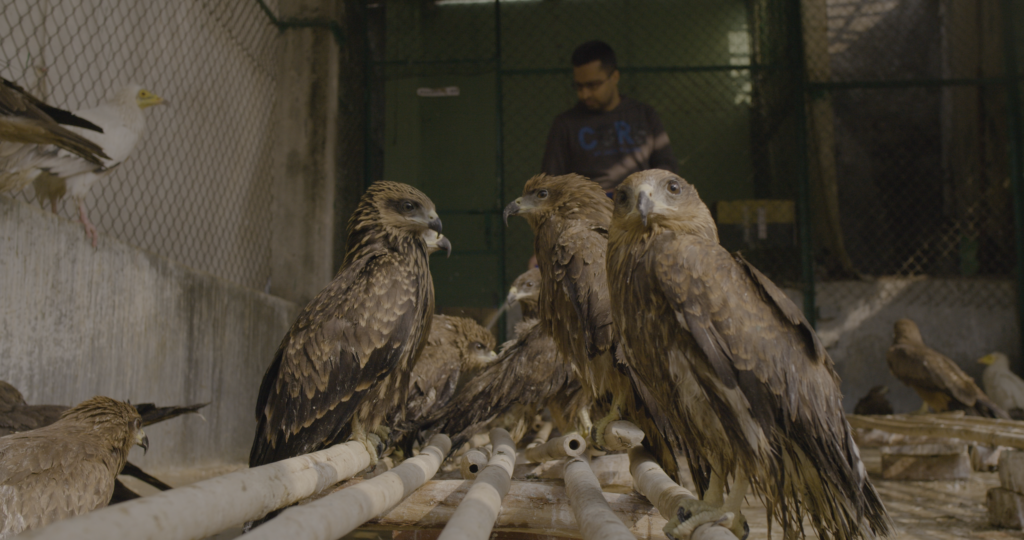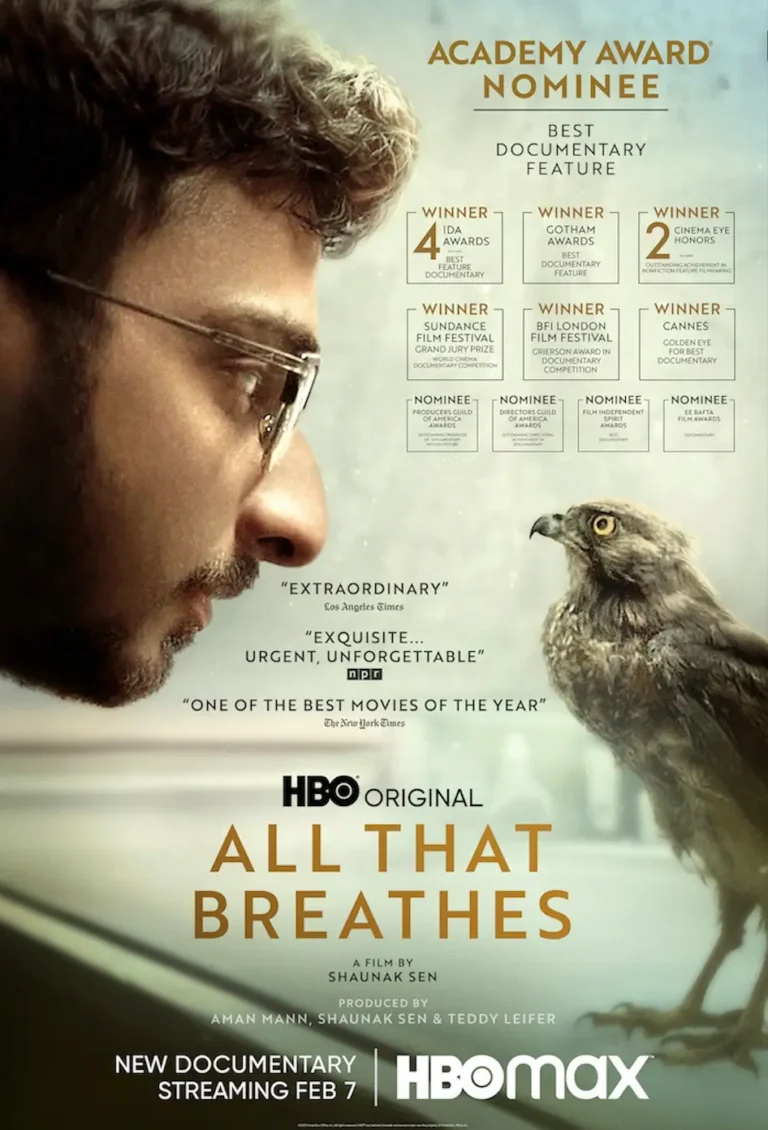All That Breathes – Snapshot
All That Breathes is an intriguing documentary about the efforts of two Muslim brothers (Nadeem and Saud) and their friend (Salik) to run a bird rescue operation in Delhi, India. With beautiful interludes of superb nature photography, it tells their story of trying to make a difference in the midst of environmental and religious conflicts that make their efforts both more necessary and more difficult. (4*)
Where to Watch:
Stream: MAX
Rent: Prime/Apple ($4); Vudu ($6)
(Note: this is a documentary by an Indian filmmaker. It is best viewed in the original Hindi language with English subtitles – unless, of course, you understand Hindi.)
All That Breathes – The Oscar Buzz
Oscar Nominations:
Documentary Feature Film
All That Breathes received a single nomination for Documentary Feature Film, putting it in our “special interest” list. (This year’s winner in that category was Navalny.)
All That Breathes – The Movie’s Family Tree
The Following Movies Share Talent with This One
(and if you like these films, you might like this one):
Cities of Sleep (15) – Director (Sen)
All That Breathes is the product of filmmaker Shaunak Sen, from India. He put together a team that included people from India and Europe. But despite lengthy research, I couldn’t identify any linkages between any of them, nor any movies that I was familiar with. Cities of Sleep was his first feature length documentary which received multiple awards in India and Europe. But, I haven’t seen that one either! So not much to go on in developing this film’s family tree.
All That Breathes – What Others Think
All That Breathes, like many documentaries, has not been seen by a lot of people, but those that have seen it weren’t very impressed. It ranks fourth among this year’s five documentaries, near the bottom of all the special interest films, and in the bottom third of all of this year’s 39 Oscar-nominated movies. (Audiences liked it a bit better than last week’s film, All the Beauty and the Bloodshed.) Overall, popular response is not very good even for a documentary.
Critics, on the other hand, – similar to last week’s film – rated this movie the best documentary and, in fact, the best movie of all 39 nominated for Oscars this year! This is yet another stunning example of how the critics and the viewing public bring different standards to the understanding of movies, especially, documentaries. (Last week’s film, All the Beauty and the Bloodshed, had nearly identical critical ratings. We will talk more about this in the last section of this review.)
Here are a few critical comments about All that Breathes: A.O. Scott (New York Times) gave the film a Critics Pick, summing up his review with “Neither a nature documentary nor a political lecture, All That Breathes is a subtle haunting reflection on the meaning of humanity – on the breathtaking kindness and heartbreaking cruelty that define our wounded, intrepid, predatory species.” Brian Tallerico (RogerEbert) wrote that the film “isn’t just a gorgeously poetic display of the natural world but a reframing of why these things should matter not just to people as devoted as Nadeem and Saud but to all of us.” And Nick Bradshaw (Sight&Sound) appreciated its filmmaking depth by calling it “a graceful piece of work, layering urban ecology, spiritual philosophy and politics into its weft.”
All That Breathes – Special Mention
Black Kites – This bird is at the center of All That Breathes, and so I looked up a few pertinent facts about it. It is a medium-sized bird of prey and, contrary to what you might gather from the film, is the most abundant species of its family and is in no danger of extinction. Their range is Eurasia with large concentrations in Southern Asia (i.e. the Indian sub-continent!) As some of the video in the film shows, they glide and soar on thermals, flying almost effortlessly, seeking their prey of small rodents and carrion. (That they are meat-eating birds is significant – see “India’s Problems” below). Over recent decades they have adapted to concentrated urban centers and dominate the skies there where they are a measurable component of the waste removal process. As the movie points out, they have adapted so well to human urban environments that they incorporate cigarette butts into their nesting material, not to eat, but only to serve as a deterrent to other species who aren’t interested in getting too close to humans.
India’s Problems – I can’t possibly write, in this review, enough to even touch upon the problems the country of India is facing right now. Just this year they became the most populous country in the world (1.49 Billion), now even larger than China. With that massive gain in numbers have come pressing problems associated with urbanization and the economic machinery to support that many people. India is the second largest burner of coal (behind China). Delhi, India’s second largest city and the setting for this movie, had the fourth worst air pollution of all cities around the world in 2022!.
When you squeeze large numbers of people into an unhealthy environment, it isn’t surprising that conflict develops. In India, religion has become the major defining source of friction and, as has happened in many places around the world, Muslims have been defined as the opposition group. (It is a political, but not necessarily factual, axiom that you need an “out” group to develop internal cohesion in your “in” group – this happens a lot in U.S. politics). As you will see in several scenes in the movie, the fact that the kite rescue team is Muslim presents, at some times, existential issues for them. When it comes to the Black Kites, it is very important that Muslims eat meat, but most of the other religions in India do not. As a consequence most animal rescue services in India will not treat the Black Kite. So, the most abundant bird in the Delhi skies, and one that contributes measurably to waste reduction, is being provided veterinary services primarily by Muslims, such as Saud, Nadeem, and Salik – themselves an endangered minority!
All That Breathes – Michael’s Moments
All That Breathes finds natural beauty in an environment saturated with smoggy air, human conflict, and natural disasters endemic now in overpopulated Delhi, India. Indian filmmaker Shaunak Sen doesn’t resist showing how Muslim life in an increasingly hostile political and religious environment is dangerous, difficult, and often frenetic. But at the same time in All That Breathes he brings his camera down to dirt level where we patiently witness animal life proceeding cautiously, but inevitably, along its own path.
The opening scene is cinematically absorbing. Starting with out-of focus human lights against a dark nighttime background, we hear the sounds of traffic and human activity. Then the camera slowly – very slowly – begins to pan downwards, and human sounds become muffled. As we lose the lights, and the camera and our eyes adjust to the darkness, we see skinny dogs moving around, scavenging through piles of human garbage. As the camera continues its downward descent, we begin to see small dark mounds in the immediate landscape, maybe just a few feet away from the camera. As these mounds start to come into focus, some of them begin to move. We realize that these mounds are really rats and there are dozens of them. Finally, as the camera nearly sinks into the earth, one of the rats seems to kiss the lens.
Rats, horses, pigs, a frog, a spider, monkeys, an owl, worms, a turtle – each one of them is featured in this film. There’s even a particularly committed snail inching along a leaf against an out-of-focus bonfire in the background. Filmmaker Sen manages to find these animals and films them as they, too, eke out an existence against the Delhi human storm. He manages to find beauty where it is difficult to imagine it could possibly exist. He captures a moment in time of All That Breathes.
But the story is that of three Muslim men trying to provide healing services to damaged Black Kite birds. And their struggle is hard. The New York Times ran a story on them back in 2020 and, apparently, that story generated financial support for their operation. Still, they are members of a religious minority in a currently hostile human environment, so their mission, neglected by many of their neighbors because the birds eat meat, is an important one, especially when the birds consume tons of waste each day. There is a feeling of human graciousness in their attempts to minister to the birds. There is also a conflicting feeling of impending doom because the men, like the birds, are facing their own dangers.
It is the contrast between the grace of their mission, the ugliness of their human story and the intrinsic parallels with the natural world that so delighted the critics. But I think its going to be a tough sell for the viewing public who may not want to be faced with such stark contrasts. This is a difficult documentary because, unlike most in its genre, it arouses so many conflicting feelings. All That Breathes is, as A. O. Scott says, “more impressionistic than reportorial” and many, if not most viewers, will find that difficult, especially in a documentary. It crosses the boundary between a documentary and an art film. (4*)


